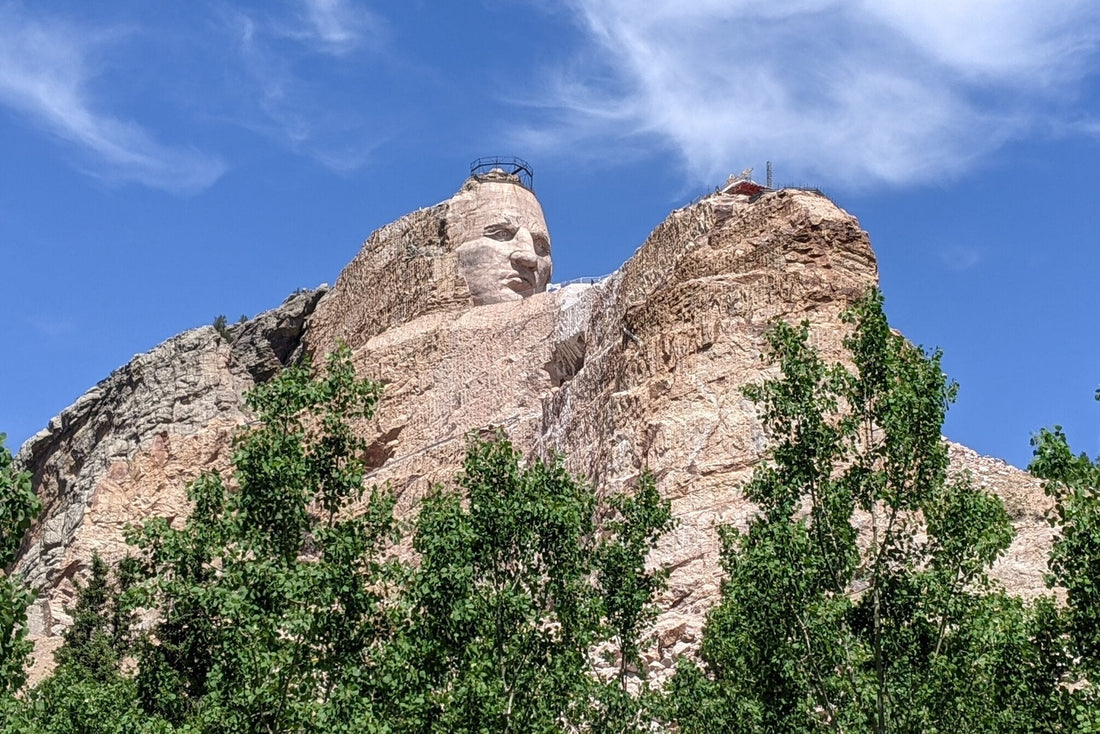Did you know deep in the Black Hills of South Dakota lies a monument called the Crazy Horse Memorial? If you were to see this monumental carving in person, it depicts the face of a Native American man, carved out of the Thunderhead Mountain in the Black Hills. According to history, the mountain and the Black Hills are classified as “sacred land by some Oglala Lakota roughly 17 miles from Mount Rushmore.” The hills are sacred land and property of the Lakota tribes who inhabit them. The memorial honors Crazy Horse, a legendary Lakota leader and warrior from the 1800s. Although the memorial is not completed yet, the final outcome will be Crazy Horse riding a horse and charging into the distance.
The Crazy Horse Memorial is the world’s largest sculpture and monument. The goal is to have the monument completed by 2035. Once completed the memorial will stand 563 feet high and be 641 feet long. This means the monument will be 6,532 feet above sea level. Thus, making it bigger than Mount Rushmore and the Statue of Liberty. Unfortunately, one of the main reasons the Crazy Horse Memorial isn’t finished is because of funding. The monument is privately funded and relies on federal donations. For example, visitors today have to pay upon entry. Regardless, this piece of artwork has a huge backstory behind its significance to Native American history and culture.

To begin, who was Crazy Horse? According to the History Channel, Crazy Horse was born in 1840 in the Black Hills. He was also the son of a shaman, whom he was named after. In the 1870s, when Crazy Horse was an adult, railroads were being built out west right through the sacred lands of Native Americans. Therefore, Crazy Horse found himself stepping into the footsteps of a leader and warrior. In 1876, he fought in two battles alongside Sitting Bull, which were the Battle of Rosebud and the Battle of the Little Bighorn. Victory was made and Crazy Horse killed General Custer.
Unfortunately, Crazy Horse found himself up against another hurdle—feeding the starving Sioux during winter. Lieutenant Philo Clark negotiated with Crazy Horse, offering him and the Sioux a reservation to live on as long as they agreed to surrender. Soon after, Crazy Horse was arrested for not abiding by Clark’s negotiation. Moreover, while being held captive in a cell in Fort Robinson, Nebraska, Crazy Horse attempted to stab a man named Little Big Man. During the struggle, an unnamed soldier “shoved a bayonet into Crazy Horse’s abdomen, piercing his kidneys.” Crazy Horse died from his injuries on the evening of September 6, 1877.

Crazy Horse’s death wasn’t the end of his legacy. It was just the beginning. In 1933, Henry Standing Bear, a Lakota chief, and Crazy Horse’s late maternal cousin heard of a monument being built in Fort Robinson, Nebraska, honoring Crazy Horse. Henry Standing Bear felt as a relative he should take the initiative in honoring his late cousin, so he advocated how the monument should be in the Black Hills. Henry Standing Bear, who was one of the first students and survivors of Carlisle Indian School in Pennsylvania, wanted his people and his cousin properly portrayed and honored.
He wrote to Korezak Ziolkowski, a Polish sculptor who worked on Mount Rushmore, asking him to build the memorial. After agreeing to build the monument, Ziolkowski said “By carving Crazy Horse, if I can give back to the Indian some of his pride and create a means to keep alive his culture and heritage, my life will have been worthwhile.” So, in 1947, Ziolkowski and his wife, Ruth, moved to South Dakota.

On June 3, 1948, a dedication ceremony was “held to commemorate the future of the memorial” and the start of the project. Unfortunately, Henry Standing Bear died five years later, and Ziolkowski, who dedicated the rest of his life living in the Black Hills sculpting the memorial, died in 1982. Fortunately, by 1998, according to the Native Hope Blog, “after 50 years of hard work and dedication” the face and head of the memorial was complete. Ziolkwoski’s wife took over the project until her death in 2014.
The 75th anniversary of the Crazy Horse memorial was celebrated in June 2023. Although the memorial still has a long journey ahead of completion, visitors are exposed to the awareness of who Crazy Horse was and the Lakota tribes who lived there. The carving of Crazy Horse charging into battle is a reminder of how he and his people persevered from colonialism. Their story and spirit live on through the memorial.
©ArtRKL™️ LLC 2021-2023. All rights reserved. This material may not be published, broadcast, rewritten or redistributed. ArtRKL™️ and its underscore design indicate trademarks of ArtRKL™️ LLC and its subsidiaries.





